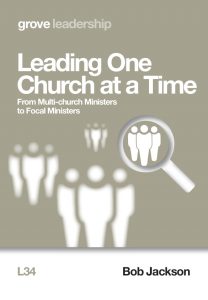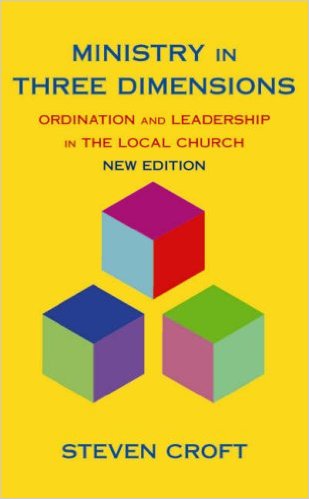Review: Leading One Church at a Time – From Multi-church Ministers to Focal Ministers
 Grove booklets are helpful little tools for the ministry toolkit. They are often insightful and informative. Occasionally, like this one, they are somewhat frustrating, because the content should be bleedingly obvious.
Grove booklets are helpful little tools for the ministry toolkit. They are often insightful and informative. Occasionally, like this one, they are somewhat frustrating, because the content should be bleedingly obvious.
Church researcher, Bob Jackson, posits the question, “As clergy numbers fall, is there a better leadership model than multi-parish incumbency?” (rear cover), and the answer is basically “Well, of course!” As church attendance declines, and the relative cost of “employing” a stipendiary vicar increases, the number of parish churches per clergy has also been increasing. Combining and amalgamating parishes sometimes works, but, in general, it stretches the mode of ministry to a breaking point, spreads the vicar too thin, and accelerates the decline. Jackson has researched the numbers (page 7).
So what do we do instead? Jackson proposes the use of “Focal Ministers”: Individuals, who are not expected to carry the burdens of incumbency (more on that later), but who can focus on the local congregation, the local community, and lead the rhythms and practices of the local church towards properly contextualised gospel ministry. Statistics show (page 9) that this is generally effective. This is not surprising. “Human communities rarely flourish without a hands-on leader. Leadership is best embedded, not absentee” (page 5).
Jackson spends his 28 pages helping us to imagine life in the Church of England with such Focal Ministers in place. He unpacks the benefits, identifies some of the pitfalls, and articulates some good practice. While opening up the “Range of Focal Ministry Options” (page 16), he maintains the “irreducible core idea… that one person leads one church” (page 3).
Taken alone, it is a simple premise, i.e. it is bleedingly obvious. The complexity and the relative obscurity lies in its juxtaposition alongside existing ecclesiastical structures, culture, and expectations, particularly in the Church of England.
To reflect on this, I have come from two different angles.
The first angle relates to what I have experienced and observed over the years.
In my experience: I am used to recognising and raising up what Jackson might call Focal Ministers (FMs). In one of my posts, the lay reader of many decades experience was clearly exercising local ministry, and much more effectively than me as I was stretched between three half-time vicarly posts; it was a no-brainer to encourage her towards increased ministry, and, eventually, ordination. In another post, Gill and I identified a young man with clear giftings and call, as he was raised into leadership we did ourselves out of a job. I could go on and on in delightful reminiscence about the numbers of coffees we’ve had to encourage people into areas of ministry (leading, preaching, pastoral care, etc.) While not all of these would be exactly the same as Jackson’s FMs, they were in the same ethos. I’m not trying to blow my own trumpet here, but isn’t this the norm? Isn’t this how ministry works? How else do you do it?
Similarly, I have been able to observe various forms of focal ministry. The Diocese of Tasmania experimented for many years with “Enabler Supported Ministry” (ESM) in which a “Local Mission Support Team” (LMST), which usually included an Ordained Local Minister (OLM), was called by the local congregation, recognised by the Bishop, and provided with a stipended “Enabler.” It differs slightly from Jackson’s model (it has a local team, not a focal minister; it is overseen by a non-authoritative Enabler rather than an incumbent in a “mini-episcope oversight role” (page 8)). When ESM worked, it worked. When it didn’t two things often emerged: 1) The LMST collapsed into one person, usually the OLM, who effectively became a Focal Minister, and 2) there were times when the Enabler needed to be given some authority in order to resolve conflict etc., and so were often also appointed as Archdeacon-Mission-Support-Officers. I don’t know if Jackson has looked at ESM (or it’s “Total Ministry”, “Every Member Ministry”, or “Local Collaborative Ministry” equivalents) but he’s arrived at a model that aligns with the outcomes.
The second angle for my reflection relates to my recent history in the Church of England. My current Diocese of Sheffield is in the midst of significant structural shifts. The development of “Mission Areas” with “Oversight Ministers” and “Focal Ministers” is a key part of the strategy. These issues are therefore very much live for me (as a recipient more than a participant in the current moment) and it has stimulated some thoughts for what to embrace, and also to avoid:
1) Focal Ministry requires a cultural change, but the danger is we only grasp it structurally: Jackson promotes FM as a way of eschewing the “pastor-and-flock model and professional ministry” (page 5). This is a strange contrast; turn over “pastor-and-flock” and you don’t quickly have a “Focal Minister” you have a flatter structure with no clear hierarchy. At best this could look like effective partnership, perhaps within a fivefold shape. At worst, (and I’ve observed this), it looks like bland egalitarianism articulated as “we don’t need anyone to lead us” and often feeling directionless and, ironically, insular. If Focal Ministry can find the balance between assertive leadership and collaborative inclusion, then that’s fantastic, but that’s firstly a cultural issue not a structural one. There’s no reason why “normal” ordained leadership should not also find that balance. Similarly, without cultural change, it will quickly reduce back to a pseudo-vicar and their flock.
2) Focal Ministry raises questions about what ordination is all about. This is not a bad thing; it raises good questions! In Jackson’s model, Focal Ministers are charged with being the “public face of the church, [the] focal leader in the community, [the] enabler of the ministry of all, [the] leader in mission” (page 20), and he can imagine them leading a congregation of up to a 100 or so (page 26). On page 23, he suggests that Focal Ministers could get started by “raising the standards of church services,” looking “for people who have left the worshipping community” to hear their story, and using festival services as a means for growth. All of that is a great description of what ordained ministry looks like on the ground! If it isn’t, then what on earth are we teaching our ordinands to do? The only aspect of ordained ministry that Jackson doesn’t really mention is theological reflection and sacramental ministry. But don’t we also want our FM’s to be theological formed, and aren’t we giving them the oversight (at least) of the celebration of the sacraments in the local context? So, conceptually, how exactly is Focal Ministry anything other than a mode of ordained ministry?
We need to think about how Focal Ministers are “searched for, trained, and supported” (page 25). One would hope that Focal Ministers would be assisted in discerning their particular vocation, provided with training in theological reflection and pastoral skill, and offered tangible support (perhaps even some remuneration where possible) so that they are free to exercise their ministry. How is this not the same concept as the pathway to ordination and the provision of a living? It may be that our training pathways for ordinands are not helpful for FMs, and that we should provide them with more flexible and contextual options. That doesn’t raise questions about the training of FMs; it raises questions about the possible general irrelevance of ordination formation! If ordination formation is relevant, why wouldn’t we offer it to FMs? If FMs don’t need it, why would we require it of ordinands?
In Jackson’s model, there isn’t really a difference in kind between Focal Ministry and Incumbency, it is a difference in degree (in his chapter 4 the only difference between “FM” and “IN” is that FMs only have one congregation and an INcumbent can still have multiple). The church offers a more rigorous (and defined) form of support to Incumbents, and a more flexible (but presumably cheaper and missionally adaptive) form of support to Focal Ministers, but they are both (in the truth of the concept) exercising the essence of ordained ministry. This is not a bad thing. However, it feels awkward because the Church’s statutory wineskin can’t easily cope with the adjustment, and we have to develop new terminology to get it there.
3) My only real concern with the model, therefore, is in its implementation. Jackson speaks of the need for “official diocesan policy” when it comes to this (page 25). He speaks of “a discernment process” for FMs “as there is with readers and OLMs” (page 25). He suggests that a “Focal Minister training syllabus will be needed, perhaps prepared nationally” (page 20). Some form of process is needed, of course, but the extent of it worries me.
The joy, and beauty, and actual point of FM is the local connection and flexible local adaptation of ministry. As soon as you have syllabi and processes that are imposed from a distance (even nationally!), they risk becoming hoops to jump rather than resources to release. Such processes often hinder local adaptation by insisting on irrelevancies, and they undermine recruitment of FMs for whom that is onerous. Too much centralised expectation and we might as well replicate (or just use) the ordination streams and send FMs off to the so-called “vicar clone factory.” We need to learn the lessons from what happened (or didn’t happen) with the aspirationally contextual Pioneer Ordained Minister schemes of 15-20 years ago.
It’s at this point of FM discernment and training that Jackson should have emphasised the role of the Incumbent Oversight Minister. Surely it is in the “mini-episcopal” incumbent that you entrust a level of discernment for who may or may not be invited into the FM role? Surely someone who has been through the “full” ordination program (and subsequently provided with the living) will have been equipped to offer formation and training to those with whom they share the work? An incumbent is both aware of the local context, and connected by their office into the wider accountability; incumbents are key to the framework working. In fact, here is the point of distinction between the two roles of incumbent and FM: incumbents are called to raise up and form, in addition to joining the focal work on the ground.
In conclusion, Jackson has given us a useful resource. The prospect of a framework that aligns with what he presents excites me. Not least of which because “it rescues incumbents from impossible job descriptions, enables some to work at a more strategic level and others to enjoy a more fruitful ministry with direct responsibility for fewer churches” (page 27). But I still slightly shake my head. This is not a new solution to a new problem. This is simply a framework around the sort of work we should have been doing anyway. No matter the exact form or nomenclature, we need to get on with it.



